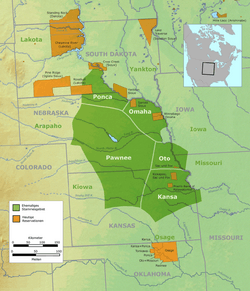Fontenelle's Post facts for kids
Fontenelle's Post was an important trading spot in what is now Nebraska. It was first built in 1822 by Joshua Pilcher, who was the head of the Missouri Fur Company. This post was one of the first European-American settlements in Nebraska. It was a busy place for trading with local Omaha, Otoe, Missouri, and Pawnee tribes.
In 1828, a French-American fur trader named Lucien Fontenelle bought the post. He worked for the American Fur Company. In 1832, he sold the post to the United States government. The government then used it as the Missouri River Indian Agency until about 1842.
Fontenelle's Post was also the first home for Moses and Eliza Merrill. They were Baptist missionaries who arrived in 1833. The US Indian agent let them use the trading post building as a temporary home. In 1835, the Merrills started the first Christian mission in Nebraska Territory to help the Otoe people.
Contents
A Busy Trading Post
In 1822, Joshua Pilcher built a fur trading post on the west side of the Missouri River. He wanted to trade with the local Native American tribes. These tribes included the Omaha, Otoe, Missouri, and Pawnee.
At that time, fur trading in the United States was not controlled by the government. Fur traders competed fiercely for this profitable business. They offered Native Americans various goods, and sometimes alcohol, to get them to trade furs.
Pilcher first competed with John Jacob Astor's American Fur Company (AFC). But in 1823, Astor bought Pilcher's post. This helped Astor create a huge fur trade business.
Lucien Fontenelle Takes Over
In 1828, a trader named Lucien Fontenelle bought Pilcher's Trading Post. Fontenelle was from a wealthy French family in New Orleans. He had started trading furs when he was 19. By age 28, he was working for the American Fur Company. The site then became known as Fontenelle's Post.
Like many traders, Fontenelle married a high-status Native American woman. This helped him form important connections with her people. Her name was Me-um-bane, which means Bright Star. She was the daughter of the main Omaha chief, Big Elk.
Lucien and Me-um-bane had five children together. Their names were Logan (born 1825), Albert (born 1827), Tecumseh (born 1829), Henry (born 1831), and Susan (born 1833). Fontenelle sent their sons to St. Louis for European-American schooling.
The Post Becomes a Government Agency
The fur trade started to slow down. This was because tastes in Europe changed, and there were fewer animals to hunt in the US. So, in 1832, Fontenelle sold the post to the US government.
The government used it as the main office for the Missouri River Indian Agency. This agency was part of the Bureau of Indian Affairs. The Bureau of Indian Affairs allowed missionaries to visit Native American lands.
In 1833, the US Indian agent let Moses and Eliza Merrill live at the Post. They were Baptist missionaries. It was their temporary home. In 1835, the Merrills started the first Christian mission in Nebraska Territory.
Fontenelle was later made a US Indian agent at Fort Laramie. His family joined him there in 1837. He passed away in 1840 when he was 40 years old.
Logan Fontenelle's Role
From 1840 to 1853, Logan Fontenelle worked at Fontenelle's Post. He was the oldest son of Lucien and Me-um-bane. Logan became an official interpreter for the US Indian agency. He earned a lot of respect from both the Omaha people and the European-American communities.
Logan was an interpreter during important talks from 1853 to 1854. These talks led to the Omaha people giving up most of their land to the United States. In return, they received payments and goods. They also settled on a reservation in northeastern Nebraska. The town of Bellevue, Nebraska grew up around the post and Indian agency. It was officially established in 1855.
Other Trading Posts Nearby
The area around Bellevue and Council Bluffs was once full of trading posts. This showed how busy the economy was with people moving west.
When Peter Sarpy came from New Orleans around 1823, he first worked for his brother-in-law, John Cabanné. Cabanné had a post for the American Fur Company. Later, Sarpy started his own trading post on the east side of the Missouri River, in what became Iowa.
Peter Sarpy's Family
Like many other fur traders, Sarpy married a local woman. Her name was Ni-co-mi from the Iowa tribe. She had a daughter named Mary Gale from her first marriage. Mary's father was John Gale, a surgeon who had been at Fort Atkinson (Nebraska). Sarpy and Nicomi also had children together.
Ni-co-mi wanted to stay with her people. Her daughter Mary Gale married Joseph LaFlesche. He was a Métis fur trader. The Omaha chief Big Elk adopted Joseph as his son. Big Elk prepared Joseph to become the next main chief of the Omaha.
Sarpy's Post in Iowa
Sarpy's post was known by many names, like Point aux Poules and Traders Point. It was owned by Astor's American Fur Company. Sarpy's Post mainly served European and United States travelers. It was especially important for outfitting pioneer groups heading west. The Post was located downriver from where Council Bluffs, Iowa is today.
By 1846, Sarpy expanded his business. He started Sarpy's Ferry. This ferry helped travelers cross the Missouri River between Bellevue and St. Mary's. He carried people going on the Oregon Trail, men heading west for the California Gold Rush, and Mormon pioneers. Sarpy County, the area around Bellevue, was named after him.
In 1849, a post office was set up on the Iowa side of the river. It was called Nebraska. In 1850, it was called the Council Bluffs Post Office. It was located at Sarpy's Point, in present-day Iowa. It reopened on the Nebraska side in 1852. It was just south of the river's curve at Sarpy's Point (Iowa) and was named Trader's Point Post Office.


